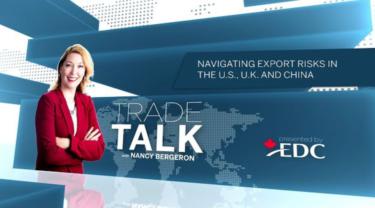What particular business risks should currently be top-of-mind for Canadian exporters, especially for the majority that are dealing with U.S. customers?
The No. 1 risk is the uncertainty around U.S. trade policy and what that may mean for Canadian companies. We do believe, however, that businesses, governments and workers on both sides of the border recognize how important it is to maintain the close links between the Canadian and U.S. economies. Consequently there would be a lot of resistance, at many levels, to any actions that might disrupt these linkages.
That said, U.S. trade policy has been unpredictable for the past several months. Will it get harder to move products and people across the border? Will there be new border taxes? How might such disruptions affect the bottom line?
These questions worry many Canadian businesses, especially since 73% of our goods and services exports go to the United States.
That proportion can be even higher for our smaller companies. Some of them do 80 to 90% of their business with U.S. customers, so there’s a lot at stake for them.
In the longer term, though, we think that Canada-U.S. trade will remain pretty much intact. The NAFTA renegotiations may lead to some revisions to the trade relationship, but some of those changes might actually be positive developments.
What specific dangers for Canadian companies could arise from this unpredictability? In the NAFTA renegotiations, for example?
If the NAFTA renegotiations are difficult and drag on indefinitely, that is a risk in itself. It creates a general uncertainty that would be bad not only for Canadian companies, but for the broader Canadian economy as well.
One major issue for the United States is the NAFTA rules of origin. Those rules are important because they determine how much overseas content a Canadian company can use in its products and still get the NAFTA tariff advantages when selling to U.S. buyers. If the product goes over that percentage, it will attract U.S. import tariffs, which can make the product too expensive for the U.S. market. So if we get tighter rules of origin, it could hurt the competitiveness of Canadian exporters that obtain some of their inputs from outside North America.
For specific sectors, the risks vary. The automotive sector, for example, supports hundreds of thousands of jobs on both sides of the border, and there’s very little interest in disrupting that integration. It’s the same for energy—in spite of some rhetoric about U.S. energy self-sufficiency, the United States wants and needs Canadian energy.
Another risk area might be the movement of people across the border. If the U.S. took a tough line on that, it could become harder for Canadian service providers to operate in the United States, and the services sector is where we’re now seeing a lot of new growth for Canadian firms.
Other NAFTA issues the U.S. wants to discuss include agricultural trade and supply management, intellectual property regulations, arbitration panels and currency manipulation. What this might mean for Canadian exporters, in practice, will depend on how the renegotiations turn out. But we need to bear in mind that Canada is an important source of inputs, resources and materials for most U.S. industries, and that these could not easily be replaced without significant disruption to U.S. supply chains and higher costs for U.S. companies and consumers.
EDC has identified U.S. political paralysis as a business risk for Canadian companies operating in the United States. What’s behind this?
This risk revolves around Congress’s apparent inability to pass major legislation, such as health care reform. Such paralysis increases uncertainty for U.S. companies, who may respond by cancelling or deferring new investments. To take one example, a lot of U.S. companies are excited about infrastructure renewal. But if an infrastructure spending program can’t get through Congress, it would obviously affect their investment plans. This uncertainty would slow overall U.S. growth, which in turn would shrink U.S. demand for Canadian products and services.
If the United States got into a trade dispute with a country other than Canada, how could this affect our exporters?
This is an indirect risk rather than a direct one. Supply chains are now spread across many countries, so any dispute or disruption in one link of a chain will affect countries elsewhere along the chain. Suppose, for example, that the United States and China got into something approaching a trade war. That would not be good for anyone, but it could also lead to a lower-growth era in the United States, which would obviously affect Canadian companies. Closer to home, consider what might happen if a U.S.-Mexico trade dispute caused the United States to take punitive measures against Mexico. Hundreds of Canadian companies have Mexican operations, and such measures would certainly affect those businesses.
During the past 15 years, many U.S. companies have shifted some of their production outside the country. A lot of this production involves key tasks and components that are critical to their business. As a result, a high level of integration and trust between suppliers and buyers has developed. Supply chains now stretch across so many countries that it’s in no one’s interest to break up those relationships—it’s too much of a risk to the global economy and too much of a risk to individual companies.
What does this mean for your U.S. risk management? Simply put, it means that one of your most important strategies is to stay in close contact with your U.S. customers. If you can work with them to get ahead of any policy changes, it will be easier to deal with the disruptions these changes might cause.
So there are several things you should consider doing.
- First, talk to your customers and be as open as possible about the risks of potential U.S. policy shifts. Make sure your buyers understand the downside to their businesses if Canadian supply is restricted, and encourage them to tell their municipal and state politicians about the dangers such a disruption would pose to local and state economies.
- Second, examine your supply chains and talk to your customers about adjusting them to control risks and costs at the border. This involves a close inspection of all aspects of your supply chain, including inputs, logistics, cross-border movement of people and capital, and how your goods are bought and sold.
- Third, work with your customers to develop contingency plans that will help coordinate joint responses to any disruptive policy changes. Treat your customers as strategic partners and provide full disclosure about your backup plans.
- Fourth, see if your customers will advise you about introducing more U.S. value and content into your products. This will reduce your vulnerability to “Buy America” policies or to changes in NAFTA rules of origin.
- Fifth, explore joint diversification strategies with your U.S. customers or other U.S. partners. You may be able to cooperate on new business ventures in the United States or even in overseas markets.
- Sixth, remind your U.S. customers, whenever you can, that trade with Canada makes major contributions to the U.S. economy and to U.S. employment levels.
- Seventh, you might consider diversifying into non-U.S. markets by taking advantage of agreements such as the new Canada-EU Trade Agreement, or by seeking opportunities in China and elsewhere.
Many companies look at best-case and worst-case scenarios to help manage and monitor business risk. They identify a specific risk event and run it through their business systems to see what it might do to their customers and to their cash flow, supply chains and investment decisions. So if a border tax were imposed, for example, the company has anticipated this and has developed a strategy for dealing with it.
There are also financial tools available from various institutions. EDC, for example, offers a full suite of trade insurance products that exporters can use to protect the bottom line.
Where can exporters find information for monitoring business risk in the United States and globally?
EDC provides many resources that exporters can use to find the information they need. Understanding the U.S. situation and what’s happening in that market, and having an insight into its potential risks, is in itself a form of risk mitigation. To explore these areas, you can refer to our Knowledge Centre or to the regularly updated articles at edc.trade.
To help monitor both U.S. and global risk, exporters can also turn to the Canadian Trade Commissioner Service, the Business Development Bank of Canada, the Chambers of Commerce in both Canada and the United States, and industry associations such as the Canadian Manufacturers and Exporters association. Other informational tools include EDC’s Country Risk Quarterly and the Canada Tariff Finder.
First, be aware of how tightly integrated the Canadian and U.S. economies are, and how this should work against any significant disruption to Canada-U.S. trade. Second, recognize that NAFTA is likely going to be revised, but that some of the changes may be positive for Canadian businesses. Third, despite some alarmist rhetoric, be confident that the trade relationship will remain economically vital for both countries—although this is still not a good time to be complacent.







